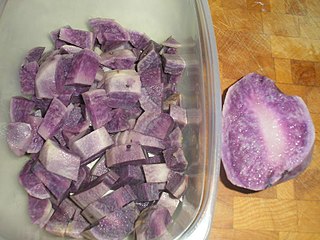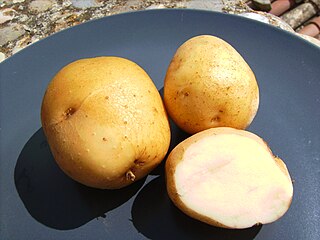
Russet Burbank is a potato cultivar with dark brown skin and few eyes that is the most widely grown potato in North America. A russet type, its flesh is white, dry, and mealy, and it is good for baking, mashing, and french fries (chips). It is a common and popular potato.

The Désirée potato is a red-skinned main-crop potato originally bred in the Netherlands in 1962. It has yellow flesh with a distinctive flavour and is a favourite with allotment-holders because of its resistance to drought, and is fairly resistant to disease. It is a versatile, fairly waxy variety which is firm and holds its shape, and is useful for all methods of cooking, from roasting to mashing and salads.
Red Gold potato is an early variety of North American potato. It has a red skin with yellow flesh inside. It is resistant to potato leafroll virus and potato virus Y and moderately resistant to common scab, but is susceptible to potato virus a and potato virus s.

Yukon Gold is a large cultivar of potato most distinctly characterized by its thin, smooth, eye-free skin and yellow-tinged flesh. This potato was developed in the 1960s by Garnet ("Gary") Johnston in Guelph, Ontario, Canada, with the help of Geoff Rowberry at the University of Guelph. The official cross bred strain was made in 1966 and 'Yukon Gold' was finally released into the market in 1980.
The Vivaldi potato is a cultivar of potato bred by HZPC, in the Netherlands, and then passed to 'Naturally Best', based in Lincolnshire, England, who promoted and distributed the potato in the UK.
Phytophthora erythroseptica—also known as pink rot along with several other species of Phytophthora—is a plant pathogen. It infects potatoes causing their tubers to turn pink and damages leaves. It also infects tulips (Tulipa) damaging their leaves and shoots.

The 'Adirondack Blue' is a potato variety with blue flesh and skin with a slight purple tint, released by Cornell University potato breeders Robert Plaisted, Ken Paddock, and Walter De Jong in 2003.

Red Norland is a red, early-maturing potato. Smaller tubers are commonly sold as “baby reds” and this variety is often served boiled or in potato salads. The progenitor variety, 'Norland', was released by the North Dakota Agricultural College in 1957. Since the release of 'Norland', other darker red skinned variants were selected, most notably 'Red Norland' and 'Dark Red Norland'. None of these three varieties is under plant variety protection. The darker red strains are now widely grown, and 'Norland' is rarely grown. 'Norland' and its selections are widely adapted, but have relatively low to intermediate yields.
Alturas is a russet potato variety released in 2002 by the USDA-ARS and the Agricultural Experiment Stations of Idaho, Oregon, and Washington and it is under plant variety protection. It is a processing potato that has cold-sweetening resistance, so it can be processed directly out of storage into French fries and other frozen potato products.

Bintje is a middle-early ripening potato variety bred in the Netherlands by the Frisian schoolmaster K.L. de Vries in 1904 from and marketed for the first time in 1910. The name of the potato, a diminutive of Benedict, was borrowed from one of his former students.
Superior is a white-skinned, white-fleshed, mid-season potato variety. It was released by the University of Wisconsin potato breeding program in 1962, and is not under plant variety protection. It is a progeny of a cross between 'B96-56' and 'M59.44' and was first grown in 1951. 'B96-56' was also a parent of Kennebec. Like the potato variety Atlantic, Superior is widely grown for potato chip manufacturing right off the field and marketable yields are fairly high.
MegaChip is a round white potato variety with good tuber size, and specific gravity for making potato chips.
Umatilla Russet is a moderately late maturing variety of potato especially suitable for frozen french fries processing. It was jointly released by the Agricultural Experiment Station of Oregon, Idaho, and Washington and the U.S. Department of Agriculture in 1998. 'Umatilla Russet' has been equal to or better than Russet Burbank in fry color in Oregon and regional trials. The potato was named by the state of Oregon after the Umatilla tribe, from which the city of Umatilla also takes its name.

Kennebec is a medium- to late-maturing white potato. It was bred by the USDA and selected by Presque Isle Station, Maine, in 1941. Kennebec is not under plant variety protection. This fast-growing variety has high yields. It maintains good quality in storage and is grown for both fresh market use and for potato chip manufacturing.
The Villetta Rose is a late maturing red potato variety. It was developed at the University of Wisconsin-Madison and is under plant variety protection. It originated from a cross between Dark Red Norland and Nordonna varieties. 'Villetta Rose' has a medium to long dormancy, stores well and maintains its red color in storage. It is grown for fresh sale and processing including canning.
Marcy is a late maturing white potato variety. It was originally bred in 1990 at Cornell University from a cross between the Atlantic variety and Q155-3 variety. It is mostly used for chipping but can be used for baking and boiling. It has good storability; chip color is good even after short to medium storage. Marcy has a high yielding crop.
Red La Soda is a red, main season potato cultivar. It is a deep red mutant of the potato variety 'La Soda'. The non-mutant form was developed by the Louisiana potato breeding program in 1948 as a cross between 'Triumph' and 'Katahdin'. The mutant form was first observed in 1949 but was not released until 1953 by the United States Department of Agriculture, (USDA) and the Louisiana Agricultural Experiment Station.
Fusarium dry rot is one of the most common potato diseases. It is caused by fungi in the genus Fusarium. This fungi causes a variety of colored rots in potatoes. This pathogen, while having both a sexual and asexual form, stays in an asexual cycle due to the way it spreads. Preferring warmer climates, it is not uncommon to find this pathogen in the northern United States where it has been reported to affect yield as much as 60%.

Melody is a cultivar of potato.
Innovator is potato variety that is oblong in shape with a smooth skin. It is a popular potato variety in Europe and is gaining popularity in North America as a frying and baking potato. The skin of the potato variety is russeted, similar to that of a Russet Burbank potato. Innovator also has shallow eyes with a cream coloured flesh.








